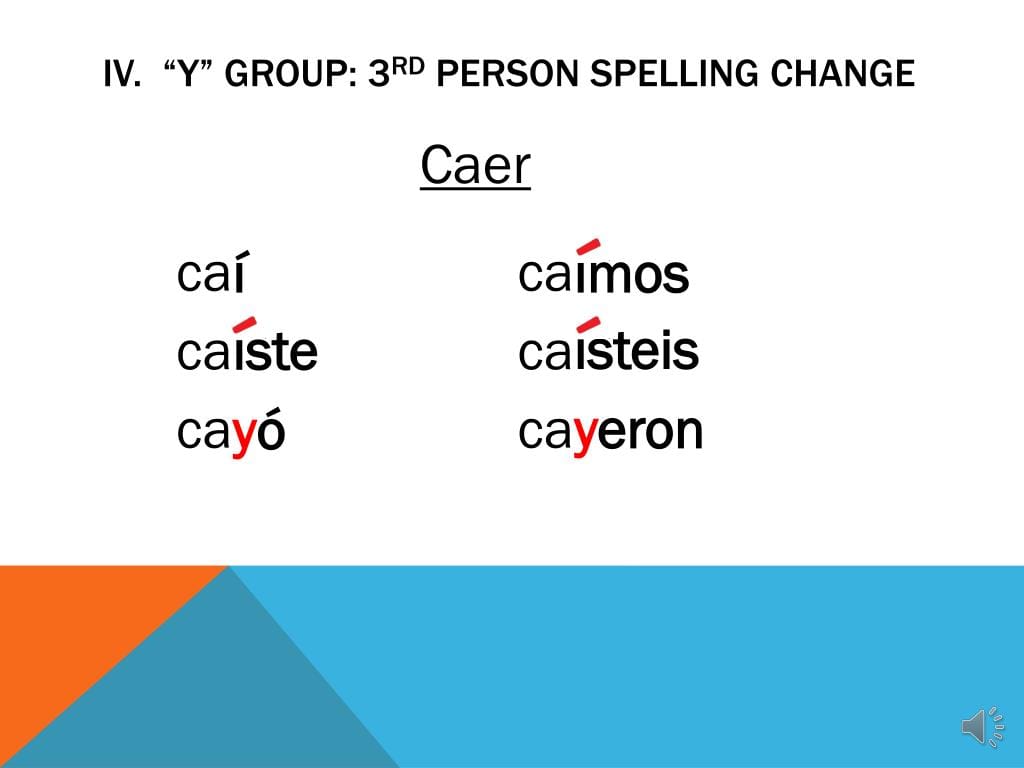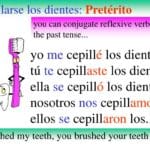This guide provides a comprehensive overview of the caer preterite, equipping you with the knowledge to accurately express “to fall” in past tense Spanish. We’ll cover everything from basic conjugation to common pitfalls and subtle nuances, ensuring you can use this irregular verb with confidence.
Understanding the Caer Preterite
Caer, meaning “to fall,” is a common Spanish verb that takes on irregular forms in the preterite tense. The preterite tense describes completed actions in the past, like “I fell” or “they dropped.” Mastering the caer preterite is vital for narrating past events, telling stories, and achieving overall fluency.
Caer Preterite Conjugation: Your Quick Reference
Here’s the essential conjugation chart for caer in the preterite tense:
| Pronoun | Conjugation | Translation |
|---|---|---|
| Yo | caí | I fell |
| Tú | caíste | You fell |
| Él/Ella/Usted | cayó | He/She/You (formal) fell |
| Nosotros | caímos | We fell |
| Vosotros | caísteis | You all fell (Spain) |
| Ellos/Ellas/Ustedes | cayeron | They/You all (formal) fell |
Key Observations and Potential Pitfalls
Several key features distinguish the caer preterite:
- Irregularity: Caer deviates from standard -ar verb conjugations in the preterite.
- Accent Marks: Crucial for correct pronunciation and meaning, most conjugations feature accent marks. Omitting them can alter the word entirely.
- ‘i’ to ‘y’ Shift: The third-person singular (él/ella/usted – cayó) and plural (ellos/ellas/ustedes – cayeron) exhibit an ‘i’ to ‘y’ shift for pronunciation consistency.
- Specific Past Time: The preterite describes a completed fall at a specific past moment (e.g., Ayer me caí de la bicicleta. – Yesterday, I fell off my bike.), contrasting with the imperfect tense, which denotes habitual or ongoing past actions (e.g., Mi hermano siempre se caía de la cama. – My brother was always falling out of bed.).
Caer vs. Caerse: A Reflexive Twist
Caerse adds a reflexive element to “to fall,” implying an accidental or unintentional fall. This introduces reflexive pronouns, further enriching the conjugation:
| Pronoun | Conjugation | Example (Meaning) |
|---|---|---|
| Yo | me caí | Me caí en la calle. (I fell in the street.) |
| Tú | te caíste | Te caíste de la silla. (You fell off the chair.) |
| Él/Ella/Usted | se cayó | Se cayó del árbol. (He/She/You (formal) fell from the tree.) |
| Nosotros | nos caímos | Nos caímos de las escaleras. (We fell down the stairs.) |
| Vosotros | os caísteis | Os caísteis en el parque. (You all (Spain) fell in the park.) |
| Ellos/Ellas/Ustedes | se cayeron | Se cayeron en la nieve. (They/You all fell in the snow.) |
Remember, these reflexive pronouns (me, te, se, nos, os, se) precede the conjugated verb.
Beyond the Basics: Expanding Your Understanding
Pronunciation Nuances: Pay close attention to the accented syllables and the ‘y’ sound in cayó and cayeron. Online resources may offer audio clips for pronunciation practice.
Avoiding Common Mistakes: Be mindful of accent marks and the ‘i’ to ‘y’ shift to ensure accuracy.
Mnemonic Devices: Memory aids can be helpful for memorizing these irregular conjugations. Create your own or find suggestions online.
Contextual Practice: Go beyond simple translation exercises. Practice using the caer preterite in diverse scenarios, such as describing accidents, narrating past events or incorporating reflexive scenarios using caerse.
Idiomatic Expressions: Explore idiomatic expressions involving caer, such as caer bien/mal (to make a good/bad impression), to expand your vocabulary and cultural understanding.
Connecting Caer with Other Verbs
Some learners find it helpful to study caer alongside other irregular verbs with similar patterns like traer (to bring) and oír (to hear). This can facilitate memorization and reveal underlying grammatical connections. Perhaps exploring cocinar conjugation or cepillarse conjugation might highlight related patterns.
The Ever-Evolving Language: A Note on Nuance
While this guide provides established conjugations, remember that language is dynamic. Regional variations and evolving usage exist. Some experts suggest that caer can also subtly imply “to happen to occur,” particularly with events. For example, La fiesta cayó en sábado (The party happened to fall on a Saturday). Keep an open mind to these nuances as you immerse yourself in Spanish.
By diligently studying these principles and engaging in consistent practice, you can confidently conquer the caer preterite and enrich your Spanish communication skills.
- Unlock Water’s Symbolism: A Cross-Cultural Exploration - April 20, 2025
- Identify Black and White Snakes: Venomous or Harmless? - April 20, 2025
- Unlocking Potential: Origins High School’s NYC Story - April 20, 2025















